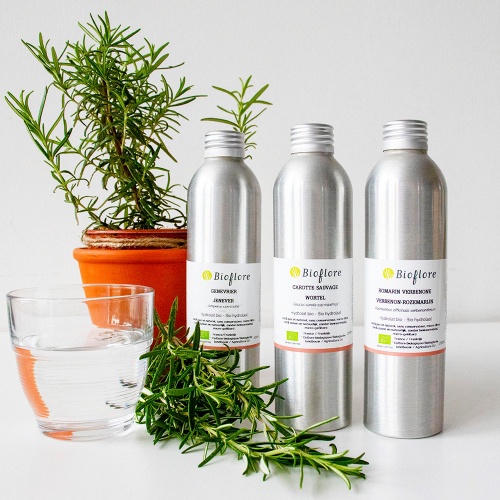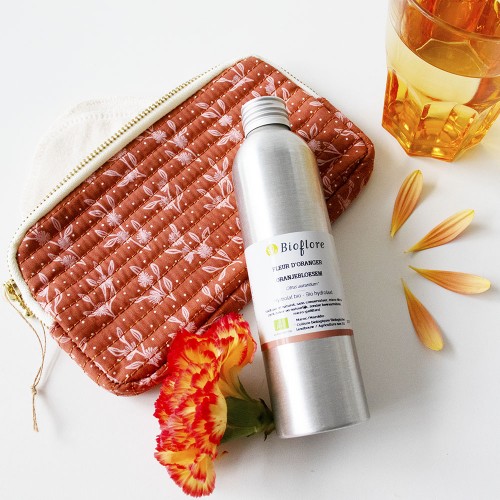To find out everything there is to know about hydrosols, follow the guide
Essential oils are the jewel in the crown of aromatherapy: they have now carved out a real place for themselves in our natural pharmacies. But are you as familiar with their twin brother, the well-known hydrosols? Aqueous in nature, hydrosols have a lot in common with their twin, but they are also different, particularly in the way they are used. One of their interesting features is that they are more user-friendly for everyone, including pregnant women and children.
An article by Amandine Devillard, aromatologist
How is a hydrosol obtained?
Hydrosols are obtained from the distillation of plants by steam distillation, the same process used to obtain essential oils. Without essential oils, there are no hydrosols and vice versa! The steam injected into the still carries away the aromatic molecules of the plants. As it cools, the water will condense again, retaining the precious plant molecules. When it comes out of the still, the hydrosol is at the bottom of the essencier, with the essential oils floating on top. Without making you an expert in chemistry, this is a question of density. The sight of these two substances separating is magical and so relaxing to watch... a real meditation!
Did you know? Historically, people first distilled plants to collect the hydrosol, not the essential oil! Indications of distillation can be found on cuneiform tablets as far back as 1200 BC.

Quality criteria for a hydrosol
These days, unfortunately, there are a lot of things that look like hydrosols - with a variety of attractive names - but aren't really hydrosols at all. Here are a few explanations and an unbeatable tip for recognising a hydrosol worthy of the name at a glance.
La materia prima: the plant
To obtain a quality hydrosol, the plant to be distilled must meet certain requirements. It must be organic to ensure that the hydrosol is pesticide-free. Some hydrosols come from wild plants that have grown in their natural environment, while others come from cultivated plants (Rose Geranium, Italian Helichrysum, for example).
A 100% pure hydrosol
A true hydrosol must meet one strict requirement from the outset: it must be distilled from plants, as we have just explained. Let's just say that water to which a synthetic rose or orange blossom flavour has been added cannot technically be called a hydrosol; nor can water to which a few drops of essential oil have been added and then distilled again.
No preservatives added
It's important to remember that a hydrosol is a fragile substance made up of water and aromatic molecules: that's all! And any product largely made up of water can become subject to bacterial or fungal contamination, which is perfectly natural. Some people therefore choose to add a preservative to their product to extend its shelf life. However, this addition limits the use of this product, which is no longer strictly speaking a hydrosol, and is therefore restricted to the cosmetic field only. At Bioflore, we do not add any preservatives.
Our hydrosols are micro-filtered, concentrated in aromatic molecules and their aluminium container protects them from wide variations in temperature, for stable hydrosols. However, we recommend that you store your hydrosols in the refrigerator, especially if you are not going to use them within a month of opening.
The concept of grade for a quality hydrosol
The quality of a hydrosol also depends on the quantity of plants used for distillation. A simple rule applies:
1 kilo of plants placed in the still = 1 litre of hydrosol harvested
If the same still receives 200 kilos of plants and the result is 300 litres of hydrosol, the hydrosol will not be as concentrated as if only 200 litres were recovered. This notion of grade 1 is not always respected because it is not currently regulated. At Bioflore, we offer grade 1 hydrosols.
How to choose a real hydrosol?
It's fairly easy to spot a genuine hydrosol at a glance. All you need to know is the Latin name of the plant (e.g. Lavandula angustifolia for true lavender hydrosol) and check that it appears alone on the bottle's INCI. If other names, including the famous Aqua, complete the INCI, the product may be an aromatic lotion, flower water or perfumed water, but not a hydrosol.

Hydrosol, floral water, what's the difference?
Technically, it's the same thing... The term hydrosol is rather general: it represents any aqueous part resulting from distillation. But not the whole plant is used for distillation; sometimes the leaves are used, sometimes the roots or even the bark of certain trees. When a hydrosol is obtained from the flowers, and only in this case, it can be called floral water. This is the case with cornflower, Roman chamomile, orange blossom or Damask rose hydrosols, which can rightly be called floral waters.
Good to know: there are hydrosols that have no essential oil equivalent. This is the case with cornflower and blackcurrant hydrosols, for example.
Who can use hydrosols?
Everyone! With a few nuances, of course, but using a hydrosol requires fewer precautions than with essential oils. But that doesn't mean you can do just anything.
However, pregnant or breast-feeding women, children, the chronically ill and people bothered by the strong olfactory impact of essential oils can turn to hydrolatherapy.

What benefits do hydrosols have?
Hydrosols are gentle, natural solutions that can be used in many everyday situations. They have their place in the bathroom and in the family medicine cabinet. From simple sprays to refresh yourself to adding them to a herbal tea, let's take a closer look at how you can use them.
The cosmetic benefits of hydrosols
Hydrosols can be used to replace many cosmetic products. They can gently cleanse the skin while maintaining its slightly acidic pH. They act as a toner after make-up removal, and can even be used as a make-up remover if the make-up is not too heavy. Here's a very simple application, sometimes forgotten, but oh so beneficial: the steam bath, also known as the facial sauna, to purify the skin and free it of toxins. Even the hair can benefit, with a spray of Atlas Cedar or Rosemary hydrosol to give it a boost.
For more in-depth cosmetic applications, hydrosols are a perfect replacement for water (or the aqueous phase) in all your DIY preparations: clay mask, day or night cream, body lotion, etc.
Hydrosols with multiple health and well-being properties
Hydrosols can also be used to promote health and well-being. Whether it's for immunity, the respiratory or digestive system, inflammation or women's problems, baby care, etc., hydrosols support the action of essential oils, or even stand on their own. Please refer to reference books on the subject for the precise uses of a particular hydrosol. It's important to remember that even though hydrolatherapy is a gentle way of taking care of yourself, it must be controlled so as not to act in an unconsidered manner.
Moreover, the sweet scent that accompanies hydrosols often supports the psycho-emotional sphere. Here's an ultra-quick way to deal with stress.
Anti-stress hydrosol synergy
- Dilute 50% orange blossom hydrosol, Roman chamomile hydrosol, fine lavender hydrosol or Damask rose hydrosol - depending on your taste - with 50% water in a bottle topped with a spray bottle.
- Spray this mixture around you as a fragrant mist to relieve tension.
Roman Chamomile Hydrosol - Organic
Soothing lotion from the earliest age
Grade : 4/5
2 reviews
How to use hydrosols?
It's easy to go green in the bathroom!
Hydrosols in the beauty routine
Used on their own as a lotion or cleanser, hydrosols can be applied directly to the skin using a washable cotton pad, or as a mist, especially if you want to use them on the scalp. If you'd like to find out more, we've put together an article on choosing the right hydrosol for your skin type.
Two sprays are usually enough for your morning or evening beauty routine.
As an ingredient in your DIY emulsions, you'll need to refer to the formula, as quantities vary widely.
Hydrosols for children and babies
From birth, hydrosols can be used to cleanse the face and bottom, to soothe irritations
- The same goes for cleansing children's faces in the morning or after a meal that has left moustaches!
- Chamomile hydrosol can be sprayed on irritated skin to relieve itching.
Hydrosols suitable for younger children:
Roman Chamomile Hydrosol - Organic
Soothing lotion from the earliest age
Grade : 4/5
2 reviews
Everything you need to know about hydrosols as natural therapeutic solutions
There are many circumstances in which hydrosols can be very useful: soothing gastric reflux, warding off a flu epidemic at home, calming a seasonal allergy, fighting a urinary tract infection, and so on. You can use a standard oral dosage for adults:
- 2 tablespoons of your chosen hydrosol (or combination of hydrosols) in a litre of water, to be drunk throughout the day.
- This dosage can be adjusted, especially for children, preferably by using teaspoons.
Hydrosols can be added to a bath (definitely not the case with pure essential oils!), applied to eye compresses (cornflower hydrosol is perfect for soothing tired eyes at the end of the day), or used to replace your usual product in a mouthwash (don't use pure essential oils!). ), apply them to eye compresses (cornflower hydrosol is perfect for soothing tired eyes at the end of the day), substitute them for your usual product in a mouthwash (in this case, it's best to use a half-hydrosol, half-water dilution, such as Laurel and Spearmint or Peppermint hydrosols), or use them to subtly spice up a mocktail.
In view of all these advantages and their wide range of uses, hydrosols are definitely gaining in popularity and taking their place alongside essential oils in the family pharmacy.






















